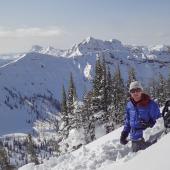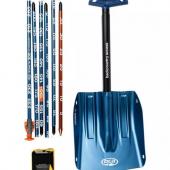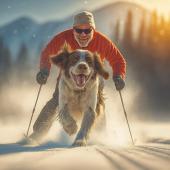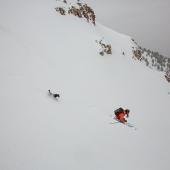Lifesaver: Will Work for Food
It’s 7:30 am and a frigid 14 degrees below zero at the Yellowstone Mountain Club. In the lingering morning darkness, despite the extreme cold, Rocco Altobelli and his canine colleague, a black lab named Japhy, load an idling snowmobile and race toward the summit of Pioneer Mountain to begin their workday with the club’s professional ski patrol. The patrolling partners represent a key component in snow-safety programs at ski areas and resorts throughout the West: avalanche rescue dog and handler.
It’s true, most fatal avalanche accidents occur in the backcountry and the probability of being caught in an avalanche during a normal day of lift-accessed skiing is virtually non-existent. However, despite area patrols’ constant monitoring of snow conditions and the use of explosives to control slides, given the right conditions, a tiny window of uncertainty always exists that an in-bound, unwitnessed avalanche is possible during operating hours.
In the late 1930s the Swiss Army began training search dogs for use in avalanche rescues. Since then, training techniques have evolved and been refined, but the goal remains the same: To quickly pinpoint the location of victims buried under snow.
In a rescue, each tick of the clock could mean the difference between life and death. Statistics indicate that victims found within fifteen minutes have a 92% chance of being alive; after 30 minutes the survival rate plunges to 30 percent. Compared to assembling large groups of volunteers to find slide casualties, search dogs prove to be more efficient, less costly, safer, and easier to assemble. A well-trained rescue dog’s great sense of smell and an agile athletic body will allow it to cover a broad search area, equivalent to the work of 20 people on foot, in an eighth of the time.
Every day our bodies shed tens of millions of dead cells. These cells, accompanied by a decomposing bacterial growth and secretions like sweat, constantly have us emitting a detectable odor vapor. The canine sense of smell is up to 10,000 times more sensitive than that of a human’s, so even while entombed under several feet of concrete-like snow, a search dog can detect a person’s scent seeping to the surface. The ability to zero in on a scent trail and alert searchers requires hundreds of hours of specialized training for both dog and handler.
Dedication, obedience, and a strong trust between dog and handler are the cornerstones of a successful team. Training usually starts when a puppy is six to ten months old. Learning is a progressive process that modifies the animal’s natural hunting and herding instincts into a yearning to pinpoint out-of-sight people and objects.
Teaching a dog begins with simple hide-and-seek type games that are aimed at getting him interested in and familiar with searching beneath the snow surface. With time and repetition, the “search game” advances through a series of steps from finding the handler crouched in an uncovered hole to searching a slope and locating a volunteer buried deep under snow.
A dog’s rewards for locating a hidden person or object are simply genuine praise and a few minutes of intense play with his favorite toy. A desire to please, a drive for play and a willing-
ness to learn are a few the most important attributes trainers seek when selecting a puppy for training.
Dogs that perform avalanche work need to be strong, fit, and able to withstand hours of exposure to the intense conditions found in high alpine environments. Due to their athletic abilities, size, and trainability, Shepherds, Labradors, and Golden Retrievers are predominantly the breeds selected by search and rescue professionals.
Dogs at the Yellowstone Club and other Montana ski resorts must be certified annually to perform avalanche work. Regional ski patrols and search and rescue professionals established the certification guidelines to ensure that all avalanche dogs adhere to and maintain a consistent standard of excellence. The test gauges response time, endurance, and the ability to work confidently in the presence of real rescue distractions such as people shouting, snowmobiles, helicopters, dog and human urine, and equipment scattered throughout the area.
Given a dog’s health and ability, its career can last for many seasons. According to Yellowstone Club’s Director of Snow Safety, Tom Leonard, “Puppies can start at YC at ten months for socialization visits. Certification testing could take place at the end of the second season. Dogs could pass the annual certification for seven to eight years or more. If they are good dogs and their health holds, I would ‘grandfather’ them in as back-up dogs.”
Since daily wear and tear can take its toll on joints and bodies, running rescue dogs up and down packed ski slopes is frowned upon. All certified dogs are trained to ride on snowmobiles, in snow cats, on chair lifts, and behind their handlers in toboggans.
Some ski areas prefer to own their dogs and lend them to a handler so if the handler quits the resort doesn’t lose its training investment. At the Yellowstone Club, dogs are owned and trained by the same person. Training and owning an avalanche dog is a labor of love. In addition to standard ski patroller wages, the Yellowstone Club compensates its certified dog teams by paying for dog food during the ski season and covering any job-related vet bills.
Rocco Altobelli and Japhy are happy to be members of the YC patrol squad. It’s hard work, requiring hours of sharpening skills and standing alert to rescue someone in need. But what other job not only allows you to bring your best friend to work, but also feeds him and embraces him as one of the gang?












